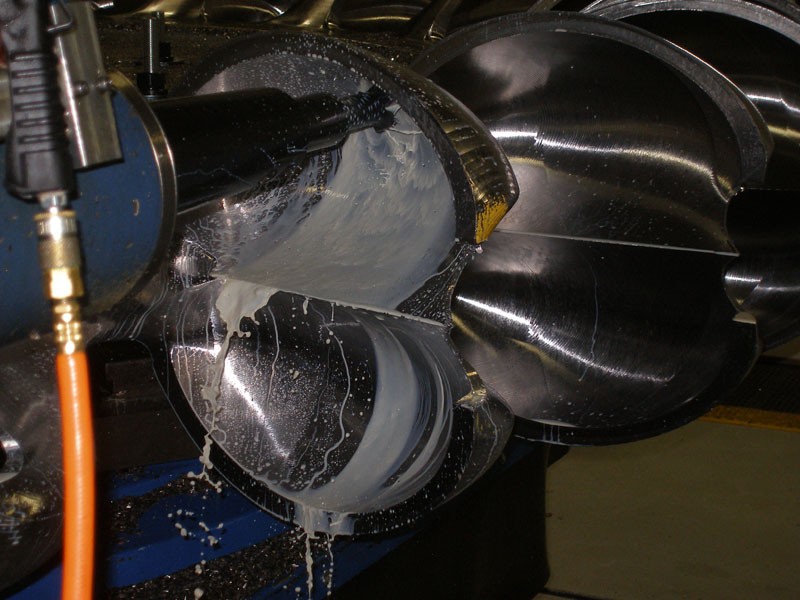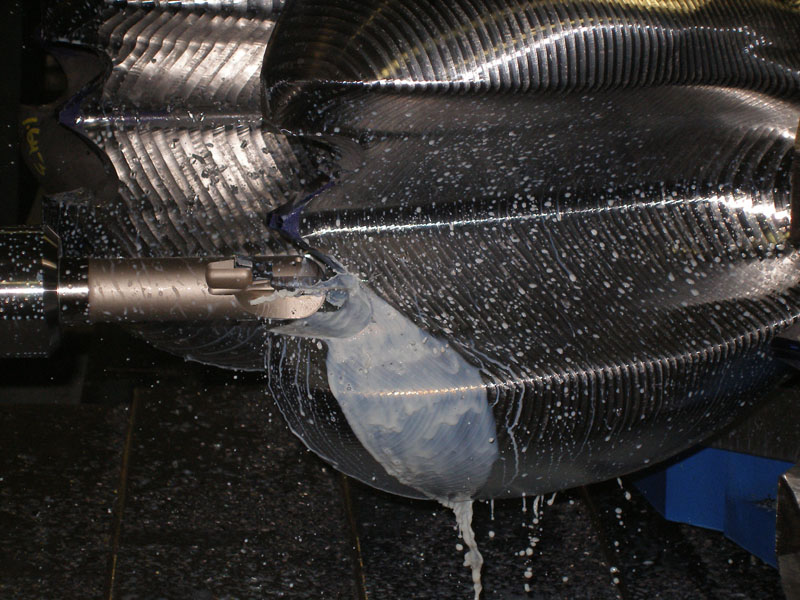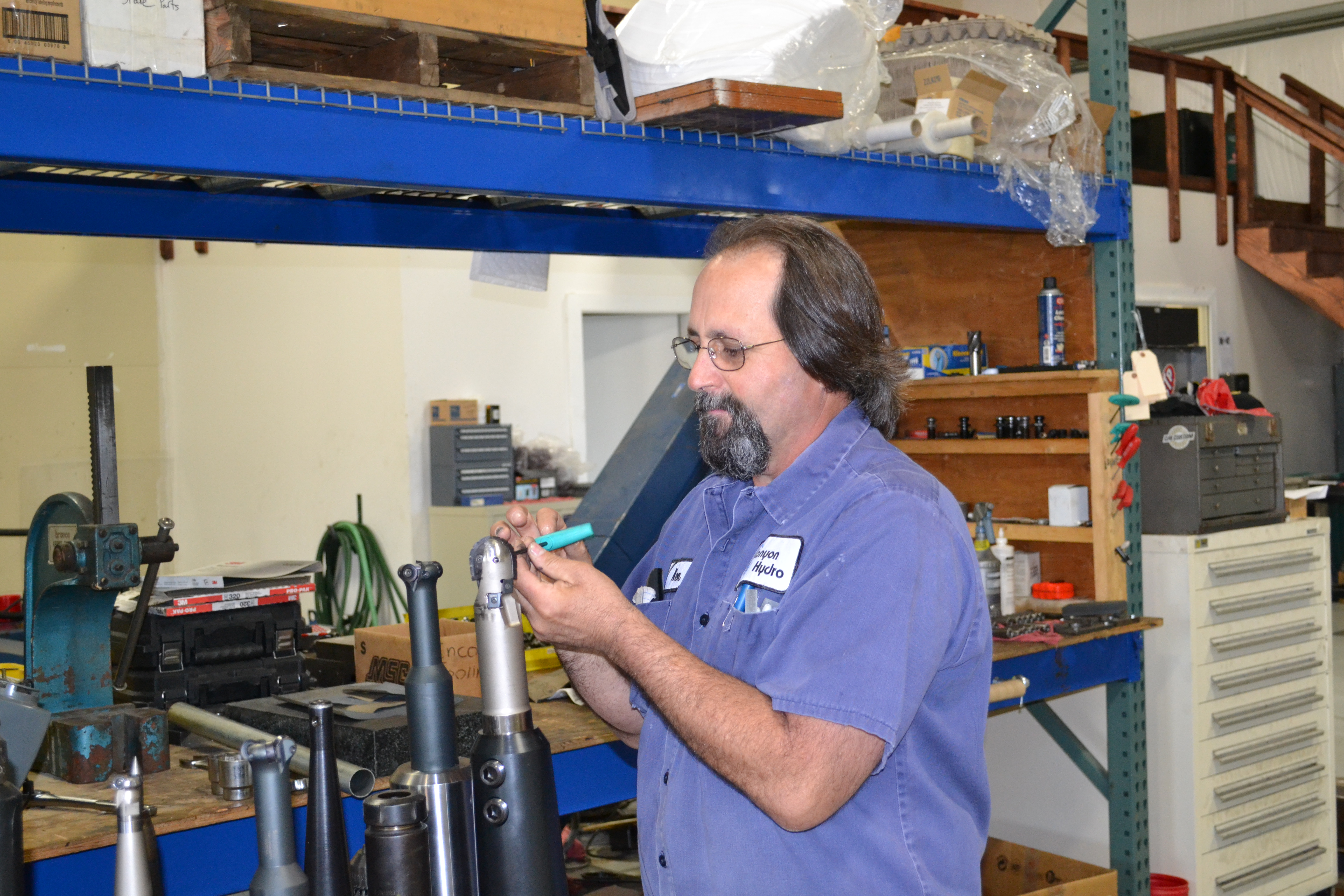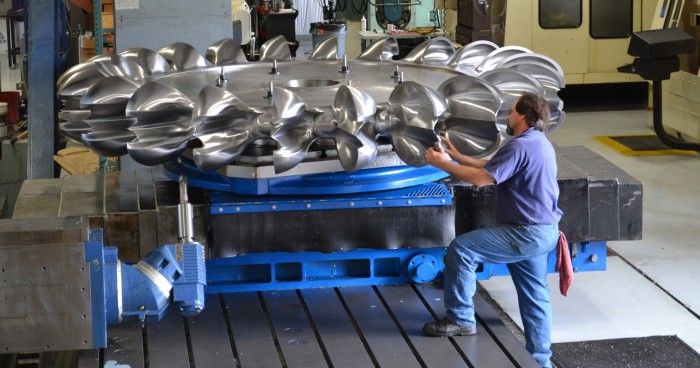Completing a Bucket List in Hydro Impeller Machining
By strategically moving to CNC automation and advanced tooling from Ingersoll Cutting Tools, this complex machining job at Canyon Hydro is now completed much faster and with much less operator attention as cycle times dropped by 50 percent, labor costs are virtually nil and tool life is reliable enough to run a lights out operation.
Posted: August 21, 2012
To defeat harmonic vibration, the three-flute tool features circular, serrated inserts in a “timed” array. Each insert is turned “five minutes” from the other so that its edges engage a different area of the cut and the whole toolpath is covered progressively with every full cutter revolution. Pips in the seat pocket mate with dimples on the backside of the insert to keep it in exact position.
The operation ran smoothly with no chatter, reducing cycle time on average by 50 percent versus manual grinding. Tool life was more than enough for lights out operation as needed.
NEW TOOLING CHALLENGES
It was February 2011 before Hansen converted the larger runners over to the automated process. He had to scale up the tool sizes accordingly. The principal model in this class is the 11-footer, with an average annual volume of 12 pieces.
The geometry of the runner buckets – six-axis contours with mostly long reaches and some undercuts – cried out for a ball mill for the most part. The sheer size of the workpieces called out for a tool much larger than most standard models. “To do a three-foot contoured cavity with a one-inch ball mill or Form-Master would take forever,” notes Hansen. “Besides, in stainless the insert would wear out too quickly for secure lights-out operation.”
Murray recommended a completely standard 2 in ProBall indexable ball nose for the bulk of the work and a modified standard Form-Master button cutter to handle the undercuts. “The button cutter works like a standard contour mill for most of the pass, then like a T-slotter when it reaches the undercut portion along the outer edge of the bucket,” explains Murray.
Hansen and Murray worked together at the work station to establish machining parameters for the ten-ton 410 NM stainless steel casting. With the big ball mill, the standard for mainstream roughing is 15 ipm, 650 rpm, 3/8 in DOC and ¼ in stepover. For finishing it is 45 ipm, 825 rpm, 0.050 in DOC and 0.100 in stepover. The undercut portions required the modified button cutter and involved the longest reaches: 20.5 in from spindle to face. Roughing parameters here are 30 ipm, 700 rpm, 0.375 in DOC and 0.100 in stepover. For finishing the settings are 45 ipm, 825 rpm, 0.050 in DOC and 0.035 in stepover.
Hansen uses these parameters during the day when the place is manned, backing down the feedrate about 10 percent as a precaution for lights-out operations. In all cases the inserts last long enough for absolute process security over 12 to15 hours; some last 45 hours per edge. “Impressive, especially in stainless steel, which can be a wildcard in any shop,” he adds.
The big two-flute ProBall ball mill features serrated inserts at the ball end plus heavy duty side cutting inserts farther up the active length for larger diameters and deeper cuts. “Visitors to our shop floor are amazed that such a large ball mill comes standard,” says Hansen. “Without it we’d be faced with either a standard or some compromise tool.” A screw-on style coupling enables in-spindle tip shuttling to 0.005 in repeatability, so there’s virtually no dead time for tool servicing.
More a modified standard than “special,” the button cutter is needed to access one portion of the cut which involves undercutting much like slotting. The backside of the tool must be effective upon withdrawal, to create the “top” of the slot. The tool uses standard inserts, with the cutter shank extended and insert seats repositioned to present cutting edges on both the front and backsides.
Hansen gave Murray the CAD file on the starting and finishing geometry of the outer lip of the bucket, then Ingersoll product specialist Mark Teno and his team back at Rockford took it from there. Working together on the shop floor, Hansen, Murray and lead CNC machinist Ken Neal have bumped up the parameters about 15 percent overall since February 2011, always paying attention to accuracy, surface quality and process security in a very chatter-prone operation. “It’s as much a matter of listening as anything else,” says Murray. “I don’t think anybody can truly optimize a long-reach stainless steel milling operation over the phone.”
Not surprisingly, all of Canyon Hydro’s runners are completed much faster and with much less operator attention as a result of the company’s strategic move to CNC automation and advanced tooling. Cycle times now average 50 percent less, labor costs are virtually nil. The mainstream 11 footer runs even better: 500 hours versus 1500 before. And the tool life is reliably long enough to enable lights out operation as needed.
“What’s most important is the improvement in repeatable accuracy and surface finish quality, which will pay off for hydropower developers whose bottom line hinges on efficiency of these runners. Holding 0.005 in to 0.010 in on geometry and near-mirror 32µ finishes at our end will make a measurable difference at theirs,” says Hansen.
Ingersoll Cutting Tools, 845 S. Lyford Road, Rockford, IL 61108-2749, 815-387-6600, Fax: 815-387-6968, info@ingersoll-imc.com, www.ingersoll-imc.com.







